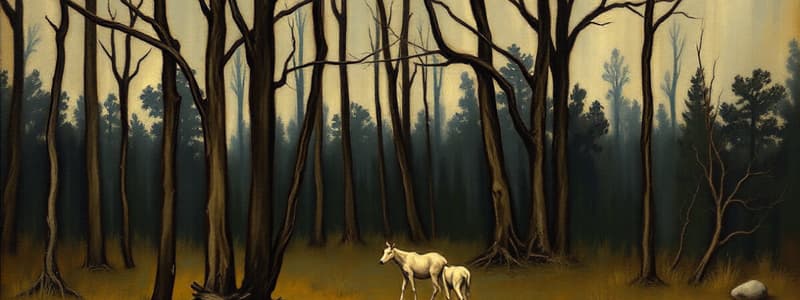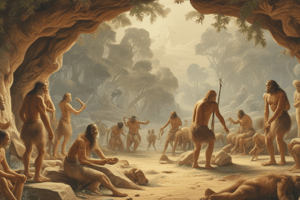Podcast
Questions and Answers
What materials were primarily used to cover the frame of a wigwam?
What materials were primarily used to cover the frame of a wigwam?
- Bark and mats made of grass and reeds (correct)
- Stone and cement
- Plastic and fabric
- Leaves and straw
What was the main purpose of girdling trees for the Woodland Indians?
What was the main purpose of girdling trees for the Woodland Indians?
- To clear land for planting crops (correct)
- To create space for new buildings
- To make wood for tools
- To attract animals for hunting
Which season signifies the first signs of plant growth for the Woodland Indians?
Which season signifies the first signs of plant growth for the Woodland Indians?
- Earring of the corn
- Budding (correct)
- Gathering of the corn
- Cohonk
What were the dimensions of a typical longhouse used by the Woodland Indians?
What were the dimensions of a typical longhouse used by the Woodland Indians?
What role did children play in relation to crop management for the Woodland Indians?
What role did children play in relation to crop management for the Woodland Indians?
Why is the information about prehistoric people limited?
Why is the information about prehistoric people limited?
What was a significant feature of the land during the Paleo-Indian period?
What was a significant feature of the land during the Paleo-Indian period?
What was the function of the atatl for Paleo-Indians?
What was the function of the atatl for Paleo-Indians?
How did the melting of glaciers affect the landscape in North America?
How did the melting of glaciers affect the landscape in North America?
What role did chiefs play in Woodland tribes?
What role did chiefs play in Woodland tribes?
Which of the following best describes how Woodland Indians obtained goods?
Which of the following best describes how Woodland Indians obtained goods?
What was one reason Woodland Indians built their villages near water sources?
What was one reason Woodland Indians built their villages near water sources?
What types of shelters did Woodland Indians primarily use?
What types of shelters did Woodland Indians primarily use?
Flashcards
Wigwam structure
Wigwam structure
A dome-shaped dwelling made from tree saplings and bark, covered in mats, with a smoke hole and a fire pit for heating and cooking. It housed 1-2 families.
Longhouse
Longhouse
A long, rectangular dwelling made from long tree poles and bark, with a capacity for 30 families. It resembled an apartment building.
Why were rivers important?
Why were rivers important?
Rivers provided access to fresh water for drinking, fishing, and transportation. They were crucial for survival in the Woodland environment.
How were forests cleared?
How were forests cleared?
Signup and view all the flashcards
What roles did children play?
What roles did children play?
Signup and view all the flashcards
Paleo-Indian Hunter-Gatherers
Paleo-Indian Hunter-Gatherers
Signup and view all the flashcards
Atlatl
Atlatl
Signup and view all the flashcards
Woodland Indian Government
Woodland Indian Government
Signup and view all the flashcards
Chief's Authority
Chief's Authority
Signup and view all the flashcards
Wampum
Wampum
Signup and view all the flashcards
Woodland Housing
Woodland Housing
Signup and view all the flashcards
The Importance of Rivers
The Importance of Rivers
Signup and view all the flashcards
Woodland Allies
Woodland Allies
Signup and view all the flashcards
Study Notes
Prehistoric People and the Woodland Indians
- Limited knowledge of prehistoric people: Prehistoric people lived before written history, making detailed information scarce.
Paleo-Indian Period
- Environment: Open grasslands, cold climate with glaciers, large herbivores.
- Animals: Large herds of herbivores, predators like woolly mammoths and saber-toothed tigers.
- Hunting tools: The atlatl, a handheld tool for accurate and speedy spear/dart throwing, enhanced hunting efficiency.
- Climate change: Melting glaciers created new rivers and lakes.
Woodland Indians
- Political structure: Tribes were governed by a chief, respected for guidance, and assisted by councils.
- Alliances: Allies agreed to mutual protection and cooperation.
- Council types: Peace councils and war councils were common in most Woodland tribes.
- Women's roles: Women had influence in decision-making, sometimes even appointing or removing council members.
- Trade and economy: Trade used bartering and wampum (clam shell beads) as a valuable form of currency.
Woodland lifestyle
- Settlement locations: Villages were situated near rivers and streams for water access, travel, and fishing.
- Temporary dwellings: During hunting seasons, temporary shelters were set up in forests for closer access to animals.
- Permanent homes: Woodland Indians lived in wigwams (rounded, bark-covered shelters) or longhouses (extended structures that housed multiple families, also called witchotts).
- Land clearing: Clearing land was accomplished through controlled burning and girdling trees.
- Food: Women and children gathered wild berries and nuts, prepared food, and preserved harvests for winter. Children also supported crop care.
- Importance of rivers: Rivers provided water, fishing opportunities, and transportation.
Woodland details
- Wigwam construction: Saplings, bark, and grass/reed mats made up wigwam structures.
- Crop care: Children actively guarded and planted crops as part of sustaining food supplies.
- Food preservation: Agricultural products were stored for winter using underground storage, keeping them cooler.
- Seasonal cycle: Woodland cultures tracked seasons like budding, earring/peak summer, gathering, and winter's arrival via migratory geese.
Studying That Suits You
Use AI to generate personalized quizzes and flashcards to suit your learning preferences.




